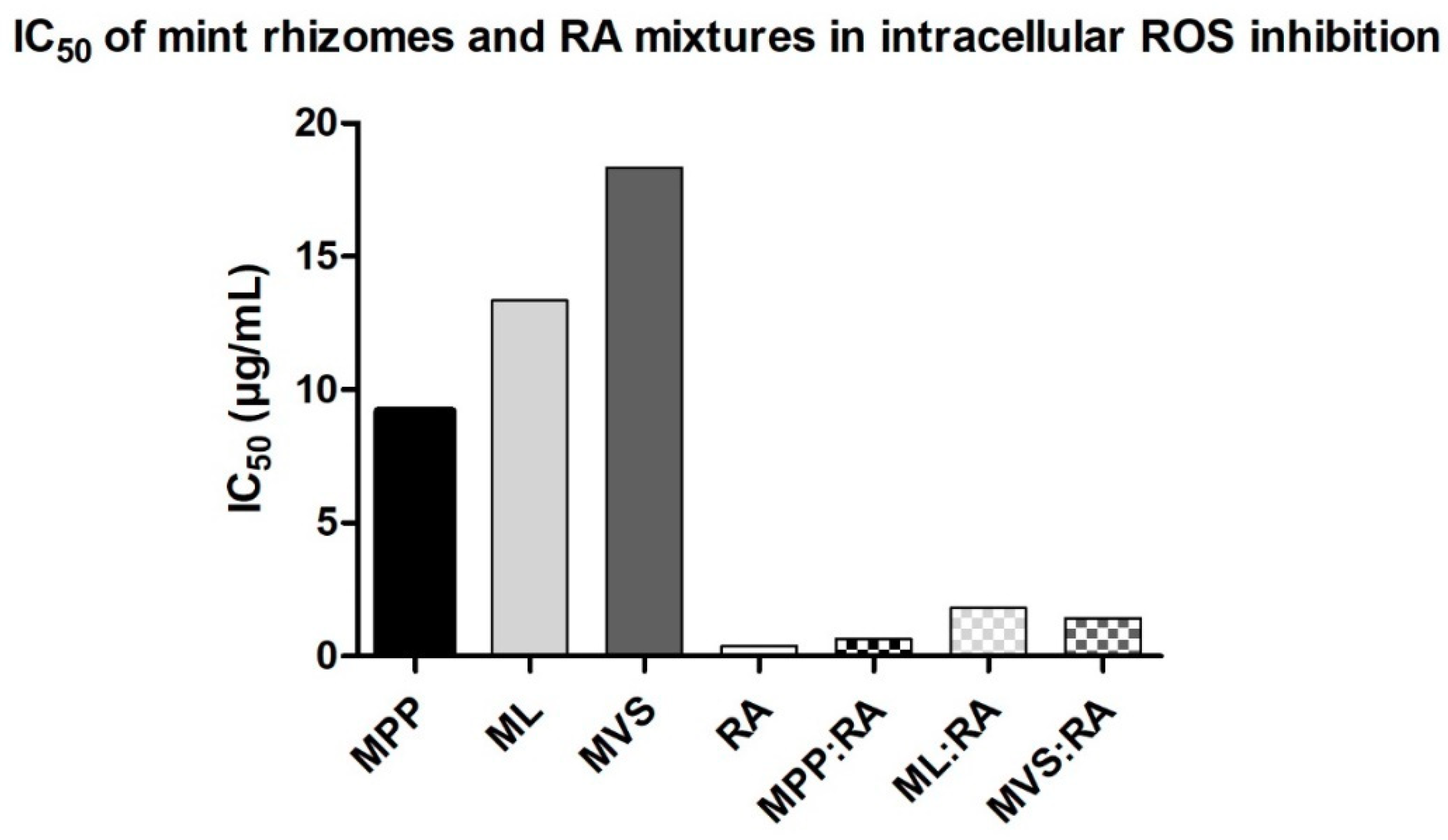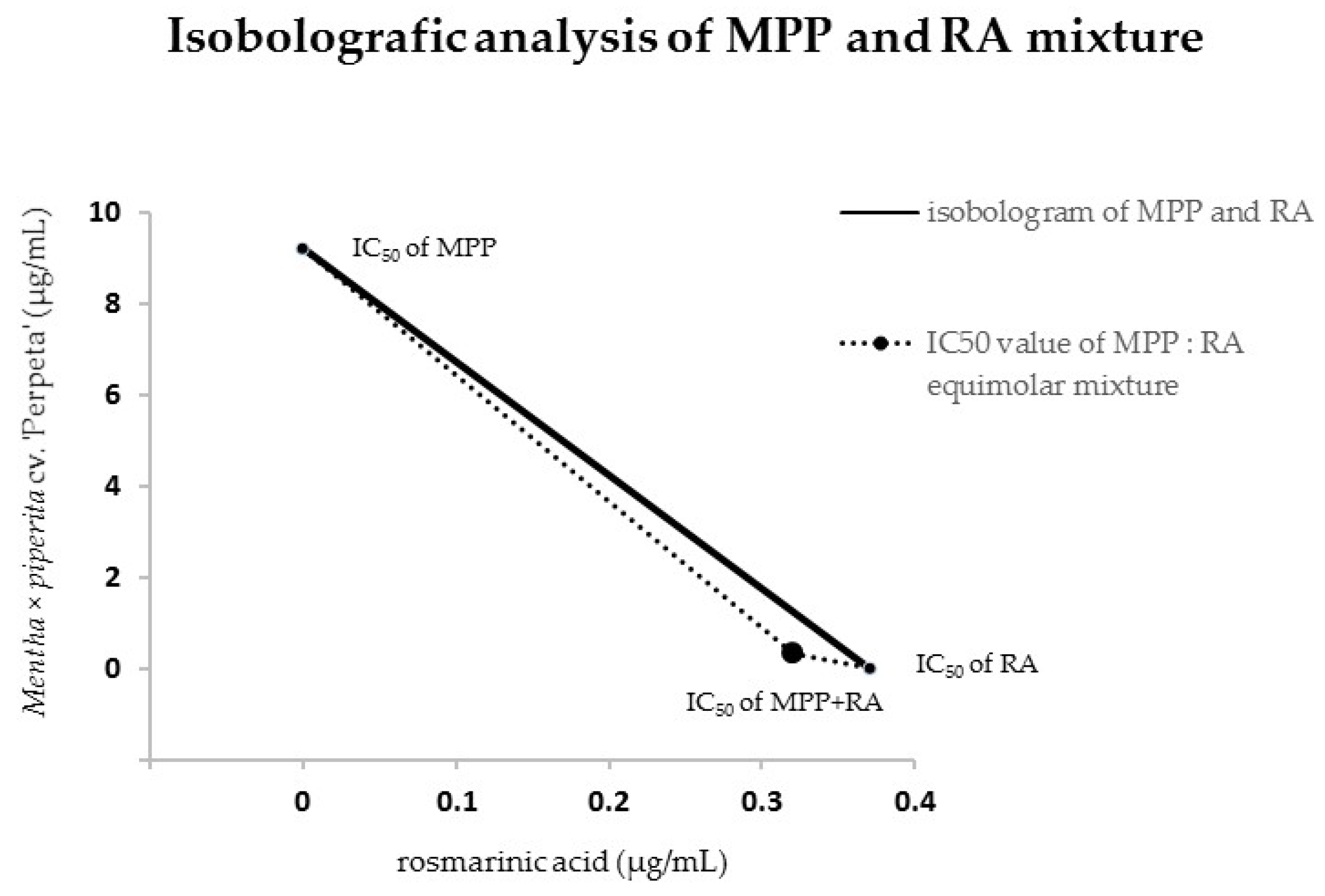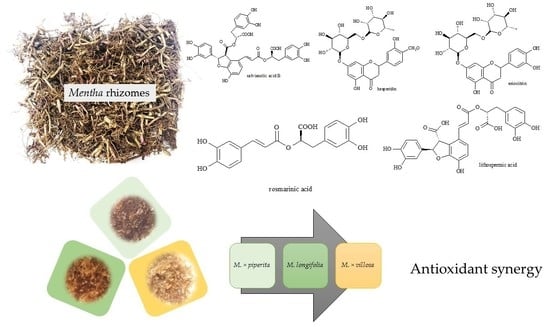Mentha Rhizomes as an Alternative Source of Natural Antioxidants
Abstract
1. Introduction
2. Results and Discussion
2.1. Phenolic Fingerprint: Identification of the Characteristic Constituents
2.2. Qualitative Determination of Constituents
2.3. In Vitro Antioxidant Activity by DPPH and ABTS
2.4. Interaction Analysis of DPPH and ABTS
2.5. Intracellular Oxidative Stress Inhibition
2.6. Interaction Analysis of Intracellular Oxidative Stress Inhibition
3. Materials and Methods
3.1. Plant Material
3.2. The Preparation of Infusions
3.3. LC-MS-DAD Analyses: Identification and Quantification of the Characteristic Constituents
3.4. Antioxidant Activity by DPPH and ABTS
3.5. Intracellular Antioxidant Activity Testing
3.6. Interaction Analysis
4. Conclusions
Supplementary Materials
Author Contributions
Funding
Acknowledgments
Conflicts of Interest
References
- Lawrence, B.M. Mint. The Genus Mentha. Medical and Aromatic Plants—Industrial Profiles; CRC Press, Taylor & Francis Group: Boca Raton, FL, USA; London, UK; New York, NY, USA, 2006; Volume 44, pp. 3–39. [Google Scholar]
- Mimica-Dukic, N.; Bozin, B. Mentha L. species (Lamiaceae) as promising sources of bioactive secondary metabolites. Curr. Pharm. Des. 2008, 14, 3141–3150. [Google Scholar] [CrossRef]
- Telci, T.; Kacar, O.; Bayram, E.; Arabaci, O.; Demirtaş, T.; Yilmaz, G.; Özcan, I.; Sönmez, Ç.; Göksu, E. The effect of ecological conditions on yield and quality traits of selected peppermint (Mentha piperita L.) clones. Ind. Crops Prod. 2011, 34, 1193–1197. [Google Scholar] [CrossRef]
- Nickavar, B.; Alinaghi, A.; Kamalinejad, M. Evaluation of the antioxidant properties of five Mentha species. Iran. J. Pharm. Res. 2008, 7, 203–209. [Google Scholar]
- Dorman, D.H.J.; Koşar, M.; Kahlos, K.; Holm, Y.; Hiltunen, R. Antioxidant properties and composition of aqueous extracts from Mentha species, hybrids, varieties, and cultivars. J. Agric. Food Chem. 2003, 51, 4563–4569. [Google Scholar] [CrossRef] [PubMed]
- Scarpati, M.L.; Oriente, G. Isolamento e costituzione dell’acido rosmarinico (dal rosmarinus off.). Ric. Sci. 1958, 28, 2329–2333. [Google Scholar]
- Hong, E.; Park, K.H.; Kim, G.H. Phenolic-enriched fractions from Perilla frutescens var. acuta: Determinating rosmarinic acid and antioxidant activity. J. Food Biochem. 2011, 35, 1637–1645. [Google Scholar] [CrossRef]
- Cuvelier, M.E.; Richard, H.; Berset, C. Comparison of the antioxidative activity of some acid-phenols: Structure-activity relationship. Biosci. Biotechnol. Biochem. 1992, 56, 324–325. [Google Scholar] [CrossRef]
- Adomako-Bonsu, A.G.; Chan, S.L.F.; Pratten, M.; Fry, J.R. Antioxidant activity of rosmarinic acid and its principal metabolites in chemical and cellular systems: Importance of physico-chemical characteristics. Toxicol. In Vitro 2017, 40, 248–255. [Google Scholar] [CrossRef]
- Mitchell, A.R.; Rechel, E.A.; Dovel, R.L. Three methods for determining storage carbohydrate concentration in peppermint (Mentha piperita) rhizomes. HortScience 1998, 33, 754–756. [Google Scholar] [CrossRef]
- Karasawa, D.; Shimizu, S. Triterpene Acids in Callus Tissues from Mentha arvensis var. piperascens Mal. Agric. Biol. Chem. 1980, 44, 1203–1205. [Google Scholar] [CrossRef]
- Croteau, R.; Sood, V.K.; Renstrøm, B.; Bhushan, R. Metabolism of Monoterpenes: Early steps in the metabolism of D-neomenthyl-beta-d-glucoside in peppermint (Mentha Piperita) rhizomes. Plant Physiol. 1984, 76, 647–653. [Google Scholar] [CrossRef] [PubMed]
- Croteau, R.; Sood, V.K. Metabolism of Monoterpenes: Evidence for the function of monoterpene catabolism in peppermint (Mentha piperita) rhizomes. Plant Physiol. 1985, 77, 801–806. [Google Scholar] [CrossRef] [PubMed]
- Kurin, E.; Atanasov, A.G.; Donath, O.; Heiss, E.H.; Dirsch, V.M.; Nagy, M. Synergy study of the inhibitory potential of red wine polyphenols on vascular smooth muscle cell proliferation. Planta Med. 2012, 78, 772–778. [Google Scholar] [CrossRef]
- Berenbaum, M.C. What is synergy? Pharmacol. Rev. 1989, 41, 93–141. [Google Scholar] [PubMed]
- Mukherjee, P.K.; Banerjee, S.; Kar, A. Exploring synergy in ayurveda and traditional Indian systems of medicine. Synergy 2018, 7, 30–33. [Google Scholar] [CrossRef]
- Yang, Y.; Zhang, Z.; Li, S.; Ye, X.; Li, X.; He, K. Synergy effects of herb extracts: Pharmacokinetics and pharmacodynamic basis. Fitoterapia 2014, 92, 133–147. [Google Scholar] [CrossRef] [PubMed]
- Liu, R.H. Potential Synergy of Phytochemicals in Cancer Prevention: Mechanism of Action. J. Nutr. 2004, 134, 3479–3485. [Google Scholar] [CrossRef]
- Kurin, E.; Mučaji, P.; Nagy, M. In Vitro antioxidant activities of three red wine polyphenols and their mixtures: An interaction study. Molecules 2012, 17, 14336–14348. [Google Scholar] [CrossRef]
- Fialová, S.; Tekeľová, D.; Grančai, D. The content of phenolic compounds in underground and aerial parts of different Mentha species. Acta Fac. Pharm. Univ. Comen. 2012, 59, 30–38. [Google Scholar] [CrossRef]
- Areias, F.M.; Valentao, P.; Andrade, P.B.; Ferreres, F.; Seabra, R.M. Phenolic fingerprint of peppermint leaves. Food Chem. 2001, 73, 307–311. [Google Scholar] [CrossRef]
- Dorman, H.J.D.; Kosar, M.; Başer, K.H.C.; Hiltunen, R. Phenolic profile and antioxidant evaluation of Mentha × piperita L. (peppermint) extracts. Nat. Prod. Commun. 2009, 4, 535–542. [Google Scholar] [CrossRef] [PubMed]
- Fialová, S.; Prinz, S.; Zehl, M.; Tekeľová, D.; Reznicek, G.; Grančai, D.; Kopp, B. Polyphenolic fingerprint of methanolic extracts of Mentha sp. cultivated in Slovakia. Planta Med. 2009, 75, SL24. [Google Scholar] [CrossRef]
- Sitzmann, J.; Habegger, R.; Schnitzler, W.H.; Grassmann, J. Comparative analysis of antioxidant activities of fourteen Mentha essential oils and their components. Chem. Biodivers. 2014, 11, 1978–1989. [Google Scholar] [CrossRef] [PubMed]
- Fialová, S.; Očková, V.; Ťažký, A.; Tekeľová, D.; Grančai, D. Antioxidačný potenciál a analýza silíc rôznych druhov rodu Mentha L. Chem. Listy 2014, 108, 984–989. [Google Scholar]
- Benabdallah, A.; Rahmoune, C.; Boumendjel, M.; Aissi, O.; Messaoud, C. Total phenolic content and antioxidant activity of six wild Mentha species (Lamiaceae) from northeast of Algeria. Asian Pac. J. Trop. Biomed. 2016, 6, 760–766. [Google Scholar] [CrossRef]
- Fialová, S.; Slobodníková, L.; Veizerová, L.; Grančai, D. Lycopus europaeus: Phenolic fingerprint, antioxidant activity and antimicrobial effect on clinical Staphylococcus aureus strains. Nat. Prod. Res. 2015, 29, 2271–2274. [Google Scholar] [CrossRef]
- Hajimehdipoor, H.; Shahrestani, R.; Shekarchi, M. Investigating the synergistic antioxidant effects of some flavonoid and phenolic compounds. Res. J. Pharmacogn. 2014, 1, 35–40. [Google Scholar]
- Peyrat-Maillard, M.N.; Cuvelier, M.E.; Berset, C. Antioxidant Activity of phenolic compounds in 2,2′-Azobis (2-amidinopropane) dihydrochloride (AAPH)-induced oxidation: Synergistic and antagonistic effects. JAOCS 2003, 80, 1007–1012. [Google Scholar] [CrossRef]
- Chou, T.C. Theoretical basis, experimental design, and computerized simulation of synergism and antagonism in drug combination studies. Pharmacol. Rev. 2006, 58, 621–681. [Google Scholar] [CrossRef]
- Fletcher, R.S.; McAuley, C.; Kott, L.S. Novel Mentha spicata clones with enhanced rosmarinic acid and antioxidant activity. Acta Hortic. 2005, 680, 31–36. [Google Scholar] [CrossRef]
- Wang, H.; Joseph, J.A. Quantifying cellular oxidative stress by dichlorofluorescein assay using microplate reader. Free Radic. Biol. Med. 1999, 27, 612–616. [Google Scholar] [CrossRef]
- Miranda-Rottmann, S.; Aspillaga, A.A.; Pérez, D.D.; Vasquez, L.; Martinez, A.; Leighton, F. Juice and phenolic fractions of the berry Aristotelia chilensis inhibit LDL oxidation in vitro and protect human endothelial cells against oxidative stress. J. Agric. Food Chem. 2003, 50, 7542–7547. [Google Scholar] [CrossRef] [PubMed]
- Marchesi, E.; Rota, C.; Fann, Y.C.; Chignell, C.F.; Mason, R.P. Photoreduction of the fluorescent dye 2′,7′-dichlorofluorescein: A spin trapping and direct electron spin resonance study with implications for oxidative stress measurements. Free Radic. Biol. Med. 1999, 26, 148–161. [Google Scholar] [CrossRef]
- Soung, D.Y.; Rhee, S.H.; Kim, J.S.; Lee, J.Y.; Yang, H.S.; Choi, J.S.; Yokozawa, T.; Han, Y.N.; Chung, H.Y. Peroxynitrite scavenging activity of lithospermate B from Salvia miltiorrhiza. J. Pharm. Pharmacol. 2003, 55, 1427–1432. [Google Scholar] [CrossRef]
- Lee, G.T.; Ha, H.; Jung, M.; Li, H.; Hong, S.W.; Cha, B.S.; Lee, H.C.; Cho, Y.D. Delayed treatment with lithospermate B attenuates experimental diabetic renal injury. J. Am. Soc. Nephrol. 2003, 14, 709–720. [Google Scholar] [CrossRef] [PubMed]
- Jin, C.J.; Yu, S.H.; Wang, X.M.; Woo, S.J.; Park, H.J.; Lee, H.C.; Choi, S.H.; Kim, K.M.; Kim, J.H.; Park, K.S.; et al. The effect of lithospermic acid, an antioxidant, on development of diabetic retinopathy in spontaneously obese diabetic rats. PLoS ONE 2014, 9, e98232. [Google Scholar] [CrossRef]
- Fernando, P.M.D.J.; Piao, M.J.; Kang, K.A.; Ryu, Y.S.; Hewage, S.R.K.M.; Chae, S.W.; Hyun, J.W. Rosmarinic acid attenuates cell damage against UVB radiation-induced oxidative stress via enhancing antioxidant effects in human HaCaT cells. Biomol. Ther. 2016, 24, 75–84. [Google Scholar] [CrossRef]
- Ghaffari, H.; Venkataramana, M.; Jalali Ghassam, B.; Chandra Nayaka, S.; Nataraju, A.; Geetha, N.P.; Prakash, H.S. Rosmarinic acid mediated neuroprotective effects against H2O2-induced neuronal cell damage in N2A cells. Life Sci. 2014, 113, 7–13. [Google Scholar] [CrossRef]
- Ramanauskiene, K.; Raudonis, R.; Majiene, D. Rosmarinic acid and Melissa officinalis extracts differently affect glioblastoma cells. Oxid. Med. Cell. Longev. 2016, 2016, 1564257. [Google Scholar] [CrossRef]
- Šarić-Kundalić, B.; Fialová, S.; Dobeš, C.H.; Ölzant, S.; Tekeľová, D.; Grančai, D.; Reznicek, G.; Saukel, J. Multivariete numerical taxonomy of Mentha species, hybrids, varietes and cultivars. Sci. Pharm. 2009, 77, 851–876. [Google Scholar] [CrossRef]
- PhBs, I.V. Pharmacopoea Bohemoslovaca; Avicenum: Praha, Czech Republic, 1987; pp. 43–44. [Google Scholar]
- Blois, M.S. Antioxidant determination by the use of a stable free radical. Nature 1958, 181, 1119–1200. [Google Scholar] [CrossRef]
- Re, R.; Pellegrini, N.; Proteggente, A.; Pannala, A.; Yang, M.; Rice-Evans, C. Antioxidant activity applying an improved ABTS radical cation decolorization assay. Free Radic. Biol. Med. 1999, 26, 1231–1237. [Google Scholar] [CrossRef]
Sample Availability: Samples of lyophilized infusions are available from the authors. |



| Peak | Compound | tR (min) | [M − H]− (m/z) | MS2 (20 eV) (m/z) |
|---|---|---|---|---|
| 1. | Protocatechuic aldehyd | 17.59 | 137 | |
| 2. | Caffeic acid | 26.67 | 179 | |
| 3. | Eriodictyol-7-O-rutinoside | 35.29 | 595 | 287 |
| 4. | 2-(3,4-dihydroxyphenyl)ethyl ester of Salvianolic acid D | 41.14 | 553 | 373, 329, 197, 179 |
| 5. | Rosmarinic acid | 45.28 | 359 | 197, 161 |
| 6. | Hesperetin-7-O-rutinoside | 47.84 | 609 | 301 |
| 7. | Salvianolic acid B | 48.16 | 717 | 519, 321, 179 |
| 8. | Lithospermic acid | 48.64 | 537 | 359 |
| 9. | Salvianolic acid A | 49.83 | 493 | 359, 313 |
| 10. | Caffeic acid tetramer | 50.30 | 715 | 535, 491 |
| 11. | Luteolin-7-O-rutinoside | 50.89 | 593 | 285 |
| Compound | Mass Concentration (μg/mL) * ± SD | ||
|---|---|---|---|
| M. × piperita cv. ‘Perpeta’ | M. longifolia | M. × villosa cv. ‘Snežná’ | |
| Protocatechuic aldehyde a | <LOQ | nd | <LOQ |
| Caffeic acid b | 2.8 ± 0.02 | nd | <LOQ |
| Eriodictyol-7-O-rutinoside c | nd | 14.4 ± 0.82 | nd |
| 2-(3,4-dihydroxyphenyl)ethyl ester of Salvianolic acid D d | 7.1 ± 3.18 | nd | 4.8 ± 0.04 |
| Rosmarinic acid d | 115.9 ± 0.29 | 54.0 ± 0.14 | 55.7 ± 0.11 |
| Hesperetin-7-O-rutinosidec | 19.3 ± 0.29 | nd | 8.9 ± 0.45 |
| Salvianolic acid B d | 14.6 ± 0.07 | 21.3 ± 0.09 | 9.0 ± 0.01 |
| Lithospermic acid d | 25.8 ± 0.06 | 82.1 ± 0.12 | 20.6 ± 0.10 |
| Salvianolic acid A d | nd | nd | 4.0 ± 0.16 |
| Caffeic acid tetramer d | nd | nd | 10.7 ± 0.10 |
| Luteolin-7-O-rutinoside c | <LOD | nd | 9.1 ± 0.28 |
| Total flavonoids | 20.8 ± 0.69 | 14.4 ± 0.82 | 18.0 ± 0.17 |
| Total phenolic acids | 166.7 ± 1.12 | 157.4 ± 0.35 | 106.3 ± 0.59 |
| Total phenolics | 187.5 ± 0.43 | 171.8 ± 0.47 | 124.3 ± 0.41 |
| Infusions Combination a | IC50 (μg/mL) b | r | CI c | SDA d | Combined Effect | DRI e | |
|---|---|---|---|---|---|---|---|
| DPPH | MPP:ML | 25.95 (28.45:25.39) | 0.98 (0.99:0.98) | 0.97 | ±0.02 | nearly additive | 2.19:1.96 |
| MPP:MVS | 33.38 (28.45:39.48) | 0.99 (0.99:0.99) | 1.01 | ±0.01 | nearly additive | 1.70:2.37 | |
| ML:MVS | 33.82 (25.39:39.48) | 0.97 (0.98:0.99) | 1.09 | ±0.02 | nearly additive | 1.50:2.33 | |
| MPP:ML:MVS | 31.68 (28.45:25.39:39.48) | 0.99 (0.99:0.98:0.99) | 1.05 | ±0.01 | nearly additive | 2.69:2.41:3.74 | |
| MPP:RA | 7.49 (28.45:2.28) | 0.98 (0.99:0.99) | 1.78 | ±0.03 | antagonism | 7.60:0.61 | |
| ML:RA | 11.01 (25.39:2.28) | 0.98 (0.98:0.99) | 2.63 | ±0.05 | antagonism | 4.61:0.41 | |
| MVS:RA | 5.33 (39.48:2.28) | 0.98 (0.99:0.99) | 1.24 | ±0.02 | moderate antagonism | 14.80:0.85 | |
| ABTS | MPP:ML | 21.83 (27.45:21.30) | 0.98 (0.97:0.98) | 0.91 | ±0.03 | nearly additive | 2.52:1.95 |
| MPP:MVS | 44.07 (27.45:40.81) | 0.98 (0.97:0.99) | 1.34 | ±0.04 | moderate antagonism | 1.25:1.85 | |
| ML:MVS | 29.21 (21.30:40.81) | 0.98 (0.97:0.99) | 1.04 | ±0.03 | nearly additive | 1.46:2.79 | |
| MPP:ML:MVS | 24.84 (27.45:21.30:40.81) | 0.96 (0.97:0.98:0.99) | 0.89 | ±0.03 | slight synergism | 3.32:2.57:4.93 | |
| MPP:RA | 3.64 (27.45:1.05) | 0.98 (0.97:0.99) | 1.80 | ±0.03 | antagonism | 15.09:0.58 | |
| ML:RA | 4.48 (21.30: 1.05) | 0.99 (0.98:0.99) | 2.24 | ±0.03 | antagonism | 9.51:0.47 | |
| MVS:RA | 3.78 (40.81:1.05) | 0.98 (0.99:0.99) | 1.85 | ±0.03 | antagonism | 21.60:0.56 |
| Infusions Combination a | IC50 (μg/mL) b | r | CI c | SDA d | Combined Effect | DRI e | |
|---|---|---|---|---|---|---|---|
| DCFH-DA | MPP:RA | 0.64 (9.21:0.37) | 0.97 (0.99:0.97) | 0.89 | ±0.04 | slight synergism | 28.74:1.17 |
| ML:RA | 1.81 (13.34: 0.37) | 0.95 (0.99:0.97) | 2.49 | ±0.10 | antagonism | 14.77:0.41 | |
| MVS:RA | 1.42 (18.34:0.37) | 0.96 (0.98:0.97) | 1.94 | ±0.08 | antagonism | 25.79:0.53 |
| Range of Combination Index | Description | |
|---|---|---|
| Synergism | <0.1 | Very strong synergism |
| 0.1–0.3 | Strong synergism | |
| 0.3–0.7 | Synergism | |
| 0.7–0.85 | Moderate synergism | |
| 0.85–0.90 | Slight synergism | |
| 0.90–1.10 | Nearly additive | |
| Antagonism | 1.10–1.20 | Slight antagonism |
| 1.20–1.45 | Moderate antagonism | |
| 1.45–3.3 | Antagonism | |
| 3.3–10 | Strong antagonism | |
| ˃10 | Very strong antagonism |
© 2020 by the authors. Licensee MDPI, Basel, Switzerland. This article is an open access article distributed under the terms and conditions of the Creative Commons Attribution (CC BY) license (http://creativecommons.org/licenses/by/4.0/).
Share and Cite
Bittner Fialová, S.; Kurin, E.; Trajčíková, E.; Jánošová, L.; Šušaníková, I.; Tekeľová, D.; Nagy, M.; Mučaji, P. Mentha Rhizomes as an Alternative Source of Natural Antioxidants. Molecules 2020, 25, 200. https://doi.org/10.3390/molecules25010200
Bittner Fialová S, Kurin E, Trajčíková E, Jánošová L, Šušaníková I, Tekeľová D, Nagy M, Mučaji P. Mentha Rhizomes as an Alternative Source of Natural Antioxidants. Molecules. 2020; 25(1):200. https://doi.org/10.3390/molecules25010200
Chicago/Turabian StyleBittner Fialová, Silvia, Elena Kurin, Eva Trajčíková, Lucia Jánošová, Ivana Šušaníková, Daniela Tekeľová, Milan Nagy, and Pavel Mučaji. 2020. "Mentha Rhizomes as an Alternative Source of Natural Antioxidants" Molecules 25, no. 1: 200. https://doi.org/10.3390/molecules25010200
APA StyleBittner Fialová, S., Kurin, E., Trajčíková, E., Jánošová, L., Šušaníková, I., Tekeľová, D., Nagy, M., & Mučaji, P. (2020). Mentha Rhizomes as an Alternative Source of Natural Antioxidants. Molecules, 25(1), 200. https://doi.org/10.3390/molecules25010200






